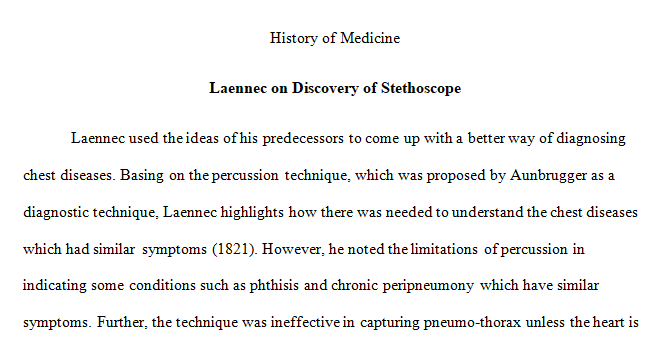
In “On the Diagnosis of Disease of the Chest,” how did Laennec associate with his innovation with his predecessors who inspired him?
History of Medicine
Readings:
Laennec, René T. H. 1821. “On the Diagnosis of Disease of the Chest.” In A Treatise on the Diseases of the Chest and on Mediate Auscultation. Translated by John Forbes, 281-293. London: Thomas & George Underwood.
Virchow, Rudolf. 1860. Cellular Pathology: As Based Upon Physiological and Pathological Histology. Translated by Frank Chance, vii-xxviii; 1-23. London: John Churchill.
Hsu, Elisabeth. 2000. “Towards a Science of Touch, Part I: Chinese Pulse Diagnostics in Early Modern Europe.” Anthropology and Medicine7.2: 251-268.
- In “On the Diagnosis of Disease of the Chest,” how did Laennec associate with his innovation with his predecessors who inspired him? How (what steps did he take) did he improve the diagnostic technique? What medical and non-medical consideration facilitated him for the improvement? What is the significance of his improvement in the field of anatomy? (Think about that Laennec could achieve but his predecessors could not.) How do you connect Laennec’s medical practices and the invention of stethoscope with his pathological view of chest diseases? What were the three classes of application of the invented stethoscope, according to Laennec? What remained limited for Laennec to examine the chest cavity with his new instrument? What do you think the purpose of which Laennec wrote this? Who would be the target reader?
- In the preface of Virchow’s Cellular Pathology, could you tell who was the target audience of this work/lecture series? What was the purpose of this work/lecture? What was Virchow’s pathological view of diseases? What was Virchow’s method of conveying his pathological view? How did Virchow prove (what were the evidences) that “cells as the ultimate active elements of the living body”? How did Virchow compare with and contrast to the humoral and solidistic views of pathology? How would you associate his view on science/ medicine with his political view?
- According to Hsu, what was Jean Baptiste Du Halde’s foundational understanding of medicine? (Think about how Du Halde seemed to impose the Galenic understanding of pulsation on the Chinese pulse patterns.) Compare Du Halde’s remark on Chinese pulse diagnostics in a basis on a conception of the body as a kind of lute with René Laennec’s mediate auscultation in diagnosing of a living body. What are the similarities? According to the author, how does Chinese tacit perception/experience of pulse taking achieve a diagnosis in a detached and descriptive way? How does a Chinese physician “calibrate” himself or herself when taking a patient’s pulse? What are the differences between “active touch” in Chinese pulse taking and “passive touch” in psychophysical practice?
Answer preview…………….

apa 970 words